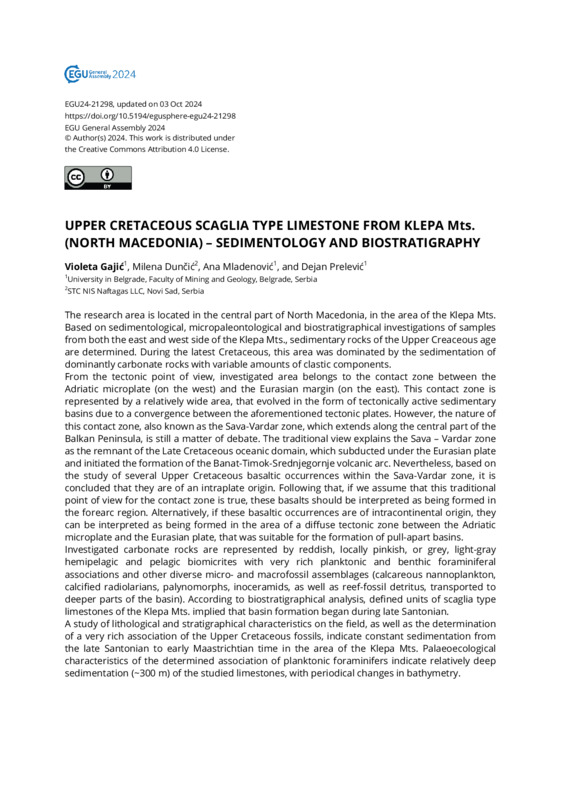Upper Cretaceous scaglia type limestone from Klepa Mts. (North Macedonia) - sedimentology and biostratigraphy
Објеката
- Тип
- Саопштење са скупа штампано у изводу
- Верзија рада
- објављена
- Језик
- енглески
- Креатор
- Violeta Gajić, Milena Dunčić, Ana Mladenović, Dejan Prelević
- Извор
- EGU General Assembly 2024
- Издавач
- European Geosciences Union
- Датум издавања
- 2024
- Сажетак
-
The research area is located in the central part of North Macedonia, in the area of the Klepa Mts. Based on sedimentological, micropaleontological and biostratigraphical investigations of samples from both the east and west side of the Klepa Mts., sedimentary rocks of the Upper Creaceous age are determined. During the latest Cretaceous, this area was dominated by the sedimentation of dominantly carbonate rocks with variable amounts of clastic components.
From the tectonic point of view, investigated area belongs to the contact zone between the Adriatic microplate (on the west) and the Eurasian margin (on the east). This contact zone is represented by a relatively wide area, that evolved in the form of tectonically active sedimentary basins due to a convergence between the aforementioned tectonic plates. However, the nature of this contact zone, also known as the Sava-Vardar zone, which extends along the central part of the Balkan Peninsula, is still a matter of debate. The traditional view explains the Sava – Vardar zone as the remnant of the Late Cretaceous oceanic domain, which subducted under the Eurasian plate and initiated the formation of the Banat-Timok-Srednjegornje volcanic arc. Nevertheless, based on the study of several Upper Cretaceous basaltic occurrences within the Sava-Vardar zone, it is concluded that they are of an intraplate origin. Following that, if we assume that this traditional point of view for the contact zone is true, these basalts should be interpreted as being formed in the forearc region. Alternatively, if these basaltic occurrences are of intracontinental origin, they can be interpreted as being formed in the area of a diffuse tectonic zone between the Adriatic microplate and the Eurasian plate, that was suitable for the formation of pull-apart basins.
Investigated carbonate rocks are represented by reddish, locally pinkish, or grey, light-gray hemipelagic and pelagic biomicrites with very rich planktonic and benthic foraminiferal associations and other diverse micro- and macrofossil assemblages (calcareous nannoplankton, calcified radiolarians, palynomorphs, inoceramids, as well as reef-fossil detritus, transported to deeper parts of the basin). According to biostratigraphical analysis, defined units of scaglia type limestones of the Klepa Mts. implied that basin formation began during late Santonian.
A study of lithological and stratigraphical characteristics on the field, as well as the determination of a very rich association of the Upper Cretaceous fossils, indicate constant sedimentation from the late Santonian to early Maastrichtian time in the area of the Klepa Mts. Palaeoecological characteristics of the determined association of planktonic foraminifers indicate relatively deep sedimentation (~300 m) of the studied limestones, with periodical changes in bathymetry. - doi
- 10.5194/egusphere-egu24-21298
- Шира категорија рада
- М30
- Ужа категорија рада
- М34
- Је дио
- RECON TETHYS
- Права
- Отворени приступ
- Лиценца
- Creative Commons – Attribution 4.0 International
- Формат
- Медија
 2024_Gajic-et-al_EGU.pdf
2024_Gajic-et-al_EGU.pdf
Violeta Gajić, Milena Dunčić, Ana Mladenović, Dejan Prelević. "Upper Cretaceous scaglia type limestone from Klepa Mts. (North Macedonia) - sedimentology and biostratigraphy" in EGU General Assembly 2024, European Geosciences Union (2024). https://doi.org/10.5194/egusphere-egu24-21298
This item was submitted on 3. октобар 2024. by [anonymous user] using the form “Рад у зборнику радова” on the site “Радови”: http://dr.rgf.bg.ac.rs/s/repo
Click here to view the collected data.